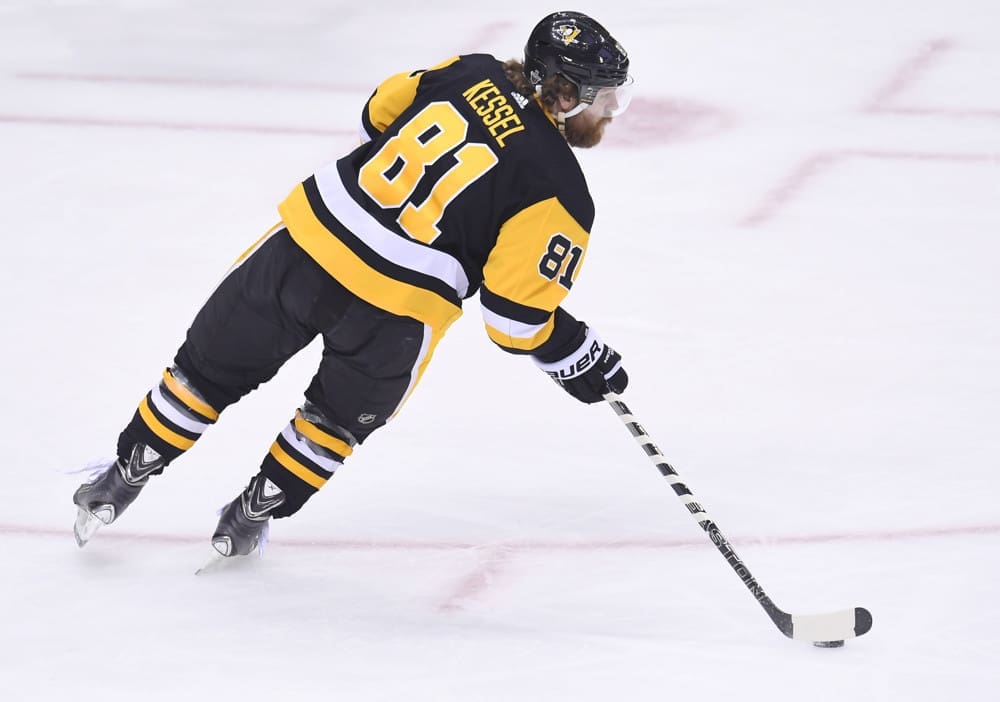Penguins
Kingerski: Why Doesn’t the Kessel-Brassard Line Work?

Without Evgeni Malkin to his left, Phil Kessel was invisible against the Colorado Avalanche, Wednesday night.
The Derick Brassard-Kessel combo generated one shot on goal. Literally, a single, measly, lonely shot. Kessel was on the ice for only three shot attempts according to the Cori counter on NaturalStatTrick.com.
Please don’t tell me we’re about to go through this saga again.
Last season, Kessel was widely rumored to be unhappy with his switch from Evgeni Malkin’s line though no proof or on the record comments ever verified the chatter. Kessel laughed off such talk in the preseason.
Wednesday, Brassard turned an intermission softball question into something a bit more serious. In the first intermission interview segment on the Penguins telecast, when asked about playing with Kessel (it must be great, right?), Brassard instead replied, “The lines are always changing pretty much every game, so we have to find a way to get scoring chances and be close to each other.”
Cue the ominous organ music.
The duo was not able to get close to each other. In the offensive zone, they might as well have been wearing different sweaters.
Kessel is a player who can score with simple, offensively vanilla centers (see also, Riley Sheahan) and talented players like Malkin, but seemingly has no chemistry with Brassard despite the potential to be a perfect fit. Actually, there is less than zero chemistry, it’s more like absolute zero.
We witnessed the same thing late last season after the Penguins acquired Brassard and paired him with Kessel. After a stellar season, Kessel played his worst hockey with Brassard which extended into the playoffs when coaches publicly implored Kessel to shoot.
So what gives?
Malkin-Kessel
There aren’t statistics to measure style of play. There isn’t any way to measure if players get too cute, stop playing simple or when those contagions spread to the rest of the team. But the Penguins were correct to separate Malkin and Kessel for several reasons, not the least of which is their contagious nature of when they veer off script.
Malkin and Kessel can be dynamic together, but they can also be destructive. Penguins head coach Mike Sullivan, the priest in the Penguins room has preached simplicity; shoot the puck, make good decisions, and play tight defensively. The technical aspects may be slightly more complicated but the message is not.
On the Penguins five-game points run, such things were ever present.
But the coaches surely noticed the team follows the Malkin-Kessel lead. On three occasions during the Penguins 10 game nightmare which preceded the five-game points streak, the Penguins snatched defeat from the jaws of victory immediately following a change to Globetrotter hockey by the LW-Malkin-Kessel line. A passed up shot on a three-on-one, bad turnovers and suddenly wide open play turned a few leads into losses.
The losses weren’t their fault any more than the other 18 players on the ice, but the Malkin-Kessel duo provided the turning points as they reverted to sloppy hockey.
So, when the pair began to cool offensively, the coaches made a switch, Tuesday in Winnipeg.
Wednesday night, had it not been for more Sidney Crosby heroics, including the natural hat trick, the Penguins would have been embarrassingly smoked by Colorado. No one else was able to score, but the Penguins engine began to turn as the game progressed. Malkin’s line found offensive life.
Malkin generated chances with Bryan Rust who also generated some offense. However, Rust continues to be the most snake bitten player since Conor Sheary, including hitting another post. With Tanner Pearson, the trio generated three scoring chances and allowed four. It wasn’t a great night, but they showed up on the stat sheet with more than an embarrassing goose egg in the shots column.
And just as we finally saw the flicker of light from Brassard for the first time in his Penguins tenure, the Brassard-Kessel pairing snuffed it out. And Kessel’s play was below the line.
Zach Aston-Reese had a couple of shots Wednesday, directly from Brassard, so the line wasn’t completely skunked.
The Penguins desperately need a third line capable of offensive production. They need balance and depth. Kessel on the third line provides both but the Penguins efforts not only have not worked, but Kessel has also looked bad in the process.
So we must ask–Why hasn’t Brassard-Kessel worked? And what will the Penguins do about it?












